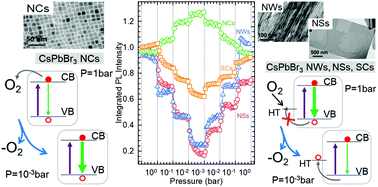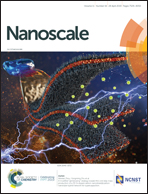O2 as a molecular probe for nonradiative surface defects in CsPbBr3 perovskite nanostructures and single crystals†
Abstract
Lead halide perovskites, owing to their flexible, scalable chemistry and promising physical properties are attracting increasing attention for solution-processed optoelectronic and photonic technologies. Despite their well-known ‘defect tolerant’ electronic structure, studies highlighted the active role of shallow and deep defect states, as well as of oxidative environmental conditions, on the optical and electrical behavior of perovskite nanocubes, films and single bulk crystals. To date, however, no in-depth systematic study of the surface trap-mediated processes in perovskite materials of different dimensionality has been conducted. In this work, we aim to bridge this gap by using O2 as a molecular probe for the effects of surface states on the exciton recombination processes of nanocubes (NCs), nanowires (NWs), nanosheets (NSs) and bulk single crystals (SCs) of CsPbBr3 perovskite. Continuous wave and time-resolved photoluminescence (PL) experiments in a controlled O2 atmosphere reveal the opposite optical response of NCs with respect to higher dimensional perovskites directly deriving from the different nature of the material surfaces. Specifically, O2 passivates surface hole-traps in NWs, NSs and SCs, leading to PL brightening with unaltered recombination dynamics. Conversely, NCs appear to be free from such surface hole-traps and exposure to O2 leads to direct extraction of photogenerated electrons that competes with radiative exciton recombination, leading to dimmed PL efficiency in atmospheric conditions. This opposite oxygen PL response demystifies the critical role of surface passivation in perovskite NCs in stark contrast to higher dimensional nanostructures and single crystals.

- This article is part of the themed collections: Advisory Board research selection and Halide Perovskite Nanocrystals


 Please wait while we load your content...
Please wait while we load your content...